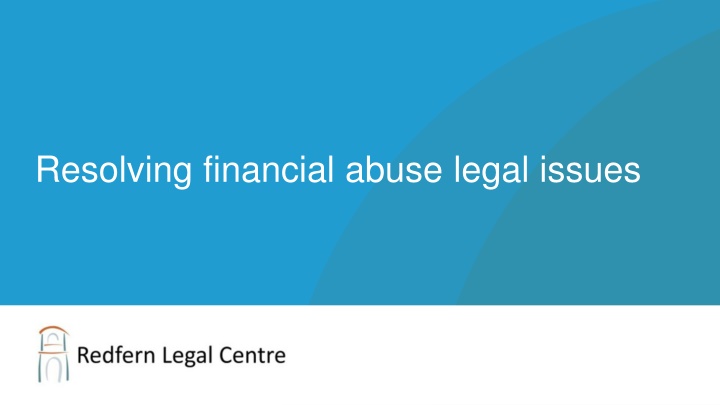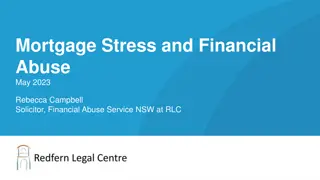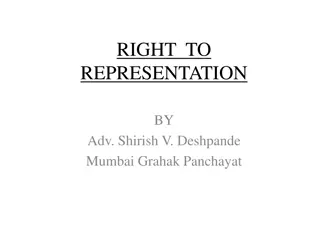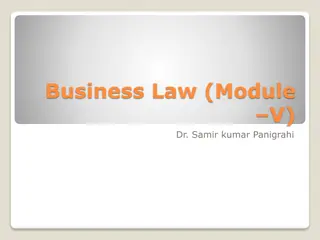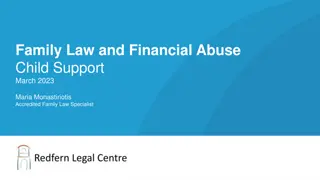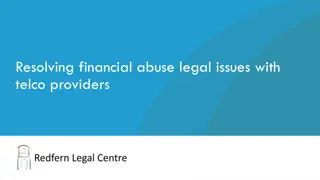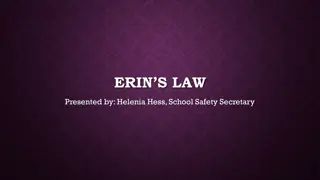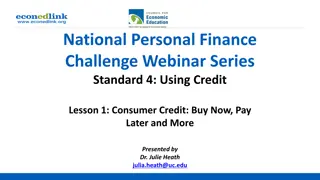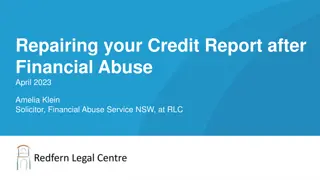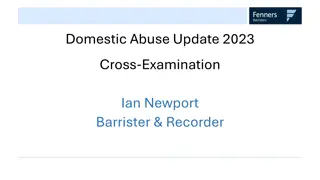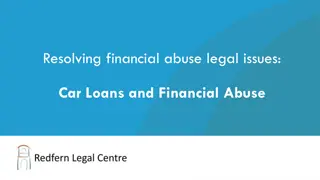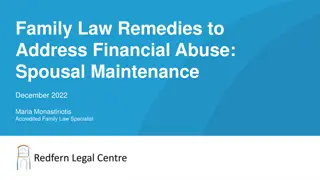Resolving Financial Abuse: Legal Issues and Consumer Credit Law
Learn about resolving legal issues related to financial abuse, consumer credit law, crafting financial hardship requests, negotiating with creditors, getting specialist legal advice, and testing your knowledge on financial matters. Gain insights into consumer credit law, the National Consumer Credit Protection Act, and the National Credit Code, along with important tips and resources. Explore the rights of individuals facing financial challenges and how to navigate the legal landscape effectively.
Download Presentation

Please find below an Image/Link to download the presentation.
The content on the website is provided AS IS for your information and personal use only. It may not be sold, licensed, or shared on other websites without obtaining consent from the author.If you encounter any issues during the download, it is possible that the publisher has removed the file from their server.
You are allowed to download the files provided on this website for personal or commercial use, subject to the condition that they are used lawfully. All files are the property of their respective owners.
The content on the website is provided AS IS for your information and personal use only. It may not be sold, licensed, or shared on other websites without obtaining consent from the author.
E N D
Presentation Transcript
Jasmine Opdam Solicitor Financial Abuse Service NSW Redfern Legal Centre
Acknowledgement Of Country
Outline 1. Consumer credit law 2. How to craft financial hardship requests 3. Tips and tricks for negotiating with creditors and debt collectors 4. When to get specialist legal advice 5. Questions and further resources RESOURCES: www.rlc.org.au/training/resources/financial-abuse
Test your knowledge True or False? 1. Financial institutions are legally required to consider requests for hardship assistance 2. If a creditor rejects a request for financial hardship assistance, there is nothing you can do about it 3. A creditor can remove a default listing from a customer s credit report where the customer has experienced financial abuse, even if the listing is correct 4. If a creditor has already obtained default judgment against your client in court, there is nothing your client can do but pay the debt 5. If your client has received a statement of claim, it is too late to make a complaint to AFCA
Test your knowledge True or False? 1. Financial institutions are legally required to consider requests for hardship assistance [TRUE] 2. If a creditor rejects a request for financial hardship assistance, there is nothing you can do about it [FALSE] 3. A creditor can remove a default listing from a customer s credit report where the customer has experienced financial abuse, even if the listing is correct [TRUE] 4. If a creditor has already obtained default judgment against your client in court, there is nothing your client can do but pay the debt [FALSE] 5. If your client has received a statement of claim, it is too late to make a complaint to AFCA [FALSE]
Consumer Credit Law The Credit Law is national legislation and has two main parts: 1. The National Consumer Credit Protection Act 2009 (NCCP) 2. The National Credit Code (at Schedule 1 of the NCCP) (NCC) Seek legal advice if a credit contract was taken out prior to 1 July 2010 as different (state-based) laws may apply. Unless otherwise stated, references in these slides are to sections of the NCCP.
What does this apply to? Consumer loans predominantly for personal, domestic or household purposes, e.g.: Car loans Consumer leases (e.g. rental contracts for goods) Personal loans Credit cards Home loans Seek legal advice if your client has a business loan, has signed a business purposes declaration or if there is any doubt whether the Credit Law applies.
When might this be relevant? Your client was coerced into signing a credit contract (e.g. credit card, personal loan, car loan etc.) could be joint or in their name only Your client s signature was forged on loan documents Your client got no benefit from the credit contract (e.g. a car loan is in their name but their partner had the full benefit of the car) Your client didn t understand the terms of the contract Your client couldn't afford the contract at the time it was approved
Responsible lending conduct Credit providers must not enter unsuitable credit contracts (s 133) and must assess the unsuitability of the contract before entering into it (s 128). In order to assess whether a loan is unsuitable a credit provider must (s 130): Make reasonable enquiries about the consumer s financial situation; Make reasonable enquiries about the consumer s requirements and objectives in seeking the loan; and Take reasonable steps to verify the consumer s financial situation.
Responsible lending conduct (cont.) A loan will be unsuitable if (s 131): The consumer cannot meet the financial obligations under the contract, or not without substantial hardship The loan does not meet the consumer s objectives and requirements. Consumers can apply for remedies including changes to the contract and compensation if credit providers breach these provisions (ss 178-9).
What are reasonable enquiries? Not defined in the legislation but ASIC has given some guidance on what these obligations require lenders to do (RG 209) Law is still developing often decided on a case by case basis There needs to be some attempt to verify income and living expenses by requesting documentary evidence, for example: Pay slips Account statements Rental leases Credit card statements
What are the consumers requirements and objectives ? Again, lender needs to make reasonable enquiries Examples of credit contracts that do not meet the consumer s requirements and objectives: A car loan for someone who doesn t have a driver s licence A credit card with a limit of $10,000 for someone who only wanted a $1,000 limit
What is an unsuitability assessment? Starting point = consumer is unsuitable for a credit contract, until lender assesses they are NOT unsuitable (s 128) Credit provider must provide a copy of the unsuitability assessment to the consumer on request (for free) up to 7 years after the contract is entered into (s 132)
What is substantial hardship? Not defined in the legislation, but for example: If the person can t afford to keep up mortgage repayments without selling their family home As of 1 January 2019, if the person cannot pay off the credit card limit (at the highest applicable interest rate) within 3 years based on their income
Obtaining documents Your client may not have all the documents you need Your client can request copies of loan documents and account information under the National Credit Code or you can request them on your client s behalf with their consent (usually written authority is required) Always include a request for a hold on any collections action to allow time for the client to get advice after the documents are produced
Acknowledging debts In most cases, court action to recover a debt must be commenced within 6 years of: 1. the date on which the debt first arose; or 2. the date the debtor last made a payment; or 3. the date the debtor last acknowledged the debt in writing The 6 years runs from whichever event from the above list occurs last. This means the time limit can re-set, so be careful when advising clients to seek information or request a waiver from a creditor.
Documents you will need Documents Relevant section s 132 NCCP When the lender must provide Within 21 business days (until 7 years after date of contract) Within 30 days Within 30 days Within 30 days Application form, unsuitability assessment & supporting information that was relied on Signed credit contract Credit related insurance contracts Any notices given under the NCC e.g. default notices Account statements Payout figure s 185(1) NCC s 185(1) NCC s 185(1) NCC s 36(1) NCC s 83 NCC Within 30 days Within 7 days
What to look for in the documents Income amount on application is higher than actual income Client had no income or only Centrelink income at time of application Other debts / liabilities are not listed or not accurate on application Contact information doesn t match your client e.g. partner s email or phone number only
What to look for (cont.) No enquiries were made about your client s income and assets e.g. lender didn t check pay slips were valid or bank statements were accurate No contact between lender and your client OR limited contact OR contact controlled by partner Credit contract almost entirely eroded equity in a secured asset e.g. house or car
What to ask your client Ask your client about their interaction (or non-interaction) with the credit provider staff (and broker if relevant) at the inception of and throughout the life of the account. Assess whether the lender / broker should have been aware of signs of abuse e.g.: Your client could be seen or heard to be taking instructions from another party Your client remained silent while the other party did all the talking Your client appeared fearful, unfocused or withdrawn (particularly if the other person was present) Your client appeared confused or reluctant to talk about what the funds being borrowed would be used for Your client disclosed the existence of an ADVO or other protection order
Distinguishing financial hardship Your client could not afford to repay the loan when it was originally obtained (or there are other indications the lender did not comply with its obligations) consider making a complaint regarding breaches of the Credit Law Your client could afford the loan when it was obtained but a change of circumstances has occurred after getting the loan consider making a request for financial hardship assistance
Working out a remedy Depends on the circumstances of the case Generally, the principal must be repaid, but fees, interest and charges should be refunded, minus any benefit the borrower received Creditors often agree to waive the full amount owing on a no admissions basis
Outcomes Reducing the amount to pay Full waiver Partial waiver Waiver of interest and/or fees Severing liability Cancellation of account Waiver of cancellation fees Refund Extending the time to pay Moratorium (short or long term hold on repayments) Hold on fees / interest / charges Payment plan Credit reporting No default listing Removal of adverse credit information e.g. defaults, enquiries
Time Limit! The time limit for taking action in relation to breaches of the responsible lending obligations is 6 years from the date of the breach. If the conduct occurred more than 6 years ago, an application under the unjust contracts provisions (ss 76 & 77 NCC) will usually be the only option.
Unjustness Defined as including unconscionable, harsh or oppressive (s 76(8) NCC). A credit contract, mortgage or guarantee can be reopened if the court is satisfied that the contract is unjust: Court may reopen unjust transactions (s 76 NCC) Court may review unconscionable interest and other charges (s 78 NCC)
Unjustness Continued The public interest and all the circumstances of the case . Matters that may be relevant: The consequences of compliance or non-compliance with the contract The relative bargaining positions of the parties Whether the contract was subject to negotiation Whether the borrower was realistically able to reject or renegotiate any of the contract provisions If the contract imposes conditions that are unreasonably difficult to comply with or not reasonably necessary to protect the legitimate interests of a party to the contract
Unjustness Continued Whether the consumer (or their representative) was reasonably able to protect their own interests because of their age, physical or mental condition The form of the contract and how it is expressed Whether the consumer received independent legal advice or other expert advice Whether the contract was explained to the consumer and whether they understood that explanation Whether unfair tactics or pressure were used on the consumer Whether the credit provider explained the consequences of the contract to the consumer
Unjustness Continued Whether the credit provider knew or could have reasonably ascertained by reasonable inquiry at that time that the consumer could not repay the loan, or could not pay it without substantial hardship Whether the terms of the transaction or the conduct of the credit provider is justified in light of the risks undertaken by the credit provider Whether any part of a mortgage will void another section of the NCC Whether in comparison with other similar loans the interest and fees are excessive Any other relevant factor
Working out a remedy Depends on the circumstances of the case If the consumer received a benefit, they (almost always) need to repay that benefit Consumer should be put back in the position they should have been in but for the unjust transaction Court has the power to re-open a contract
Time Limit! The time limit for taking action in relation to unjust contracts is 2 years from when the credit contract is rescinded or discharged or otherwise comes to an end (s 80 NCC).
What is EDR? Free service for resolving disputes between consumers and members of the scheme. Different schemes for different industries. EDR membership is compulsory for most industry participants, e.g. lenders, finance brokers, mortgage managers, mortgage originators must be members of AFCA as a condition of their credit licence. Alternative to court when attempts to resolve a dispute directly with the credit provider (through IDR) have been unsuccessful. Time limits apply for making complaints always check them before advising a client.
EDR schemes Scheme Australian Financial Complaints Authority (AFCA) Required members Banks and other credit providers Financial planning firms General insurers Payday lenders Insurance broking firms Life insurers Superannuation fund trustees RSA providers Stockbroking firms Fund management companies Debt collectors All landline, mobile phone and internet service providers All authorised electricity and gas retailers and distributors, and licenced water providers in NSW Telecommunications Industry Ombudsman (TIO) Energy & Water Ombudsman NSW (EWON)
Benefits of AFCA Free for the consumer no adverse costs No formal rules of evidence designed for self-represented complainants Enforcement action is on hold the creditor cannot: Commence or continue legal proceedings List the debt for default Sell or assign the debt to a debt collector o o o EDR schemes can make repayment arrangements on the grounds of financial hardship (vary the credit contract) under the Credit Law
Time Limit! Australian Financial Complaints Authority (External Dispute Resolution) Complaints under the National Credit Code (e.g. responsible lending, financial hardship, unjust transactions, unconscionable interest/charges) the later of either: 2 years from when the credit contract comes to an end; or 2 years from when a final response is given at Internal Dispute Resolution. Other complaints the earlier of either: 6 years from when the consumer first became aware (or should reasonably have become aware) that they suffered the loss; or 2 years from when a final response is given at Internal Dispute Resolution.
Legal resources Credit Law Toolkit ASIC Regulatory Guide 209 Credit licensing: Responsible lending conduct ABA Banking Code of Practice RESOURCES: www.rlc.org.au/training/resources/financial-abuse
2. How to craft financial hardship requests
Financial hardship Credit providers have a legal obligation under the Credit Law to provide financial hardship assistance (s 72 NCC) A debtor who is unable to meet their repayments under a credit contract or lease because of illness, unemployment or other reasonable cause can give the credit provider notice, either verbally or in writing.
AFCA guidelines Fast track financial hardship requests where DFV is disclosed Have specialised staff within financial hardship teams to assist survivors of DFV Co-borrower s consent not required for hardship requests Co-borrower s financial circumstances not taken into account when considering hardship requests
Financial hardship timeframes Within 21 days of the hardship notice, the credit provider can ask the debtor for relevant information Credit providers must respond to the hardship notice within set timeframes including reasons for refusal and details of the relevant EDR scheme Credit providers usually cannot commence enforcement proceedings until 14 days after a notice of refusal following a hardship notice
If the Credit Law doesnt apply Loans not covered by the Credit Law: business leases or loans, short term loans (under 2 months, with low interest/fees), investment loans Obligations to provide financial hardship assistance under other codes: Banking Code of Practice (banks) Customer Owned Banking Code of Practice (credit unions) Mortgage & Finance Association of Australia o o o Can still make a complaint to AFCA if credit provider is a member
Drafting a financial hardship request 1. Safety warning 2. Description of the relationship & financial abuse 3. Description of client s financial position 4. Request for remedy (full waiver? partial waiver? payment plan?) 5. Request for removal of default listing from credit report 6. Enclose supporting evidence
Supporting evidence Centrelink Income Statement / pay slips Financial Position Statement Medical letters / reports Protection order Letters from support services Bank statements
Response No agreement Successful resolution! Further negotiations Escalate internally (internal dispute resolution) Escalate externally (external dispute resolution) Refer for legal advice Full and final settlement Settlement Deed? Remove default listing from credit report
3. Tips and tricks for negotiating with creditors and debt collectors
General tips: taking instructions Record a detailed chronology of events from before, during and after the relationship. Ask for any documents the client has about their debts including in emails, online accounts, apps etc. Assist the client to request documents and information from the debt collector and original creditor. Request a hold on any collections action while waiting for documents.
General tips: making contact Establish authority with the external stakeholder as soon as possible. Ask about the stakeholder s domestic violence / financial abuse / financial hardship policies (these may not be publicly available). Revoke the abuser's authority to contact the creditor. Gather evidence of the client s circumstances and financial situation e.g. protection orders, Centrelink statements, payslips, letters from treating medical professionals and support services etc.
General tips: strategy If appropriate, include details of your client s financial hardship even when making a consumer complaint Start with the most favourable outcome and negotiate down Be clear and unambiguous about your proposed remedy Always request removal of default listings and adverse credit information
Negotiating with Financial Service Providers
